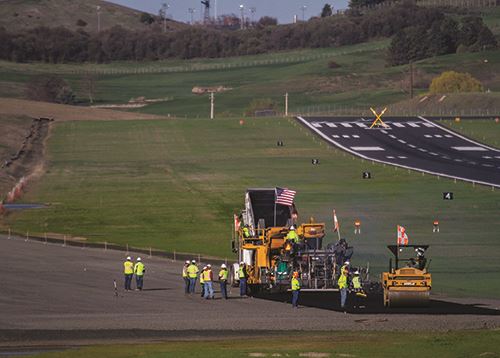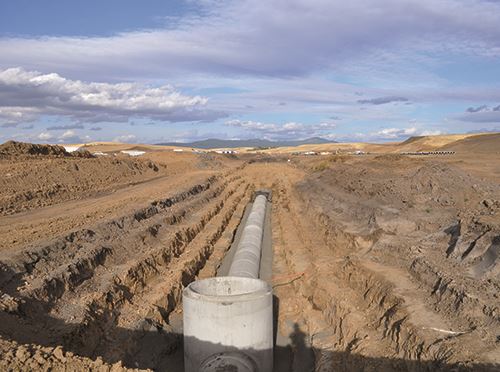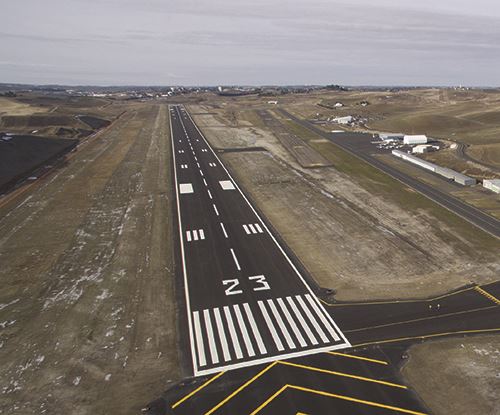When Pullman-Moscow Regional Airport (PUW) in Pullman, WA, cut the ribbon on its new $154 million runway last October, officials celebrated much more than a major capital improvement. They celebrated one of the last steps in a complicated venture that spanned more than 10 years and required cooperation among a long list of key stakeholders.
When Pullman-Moscow Regional Airport (PUW) in Pullman, WA, cut the ribbon on its new $154 million runway last October, officials celebrated much more than a major capital improvement. They celebrated one of the last steps in a complicated venture that spanned more than 10 years and required cooperation among a long list of key stakeholders.
 Quarterbacked by engineering consulting firm Mead & Hunt, the multifaceted project required PUW to acquire 300+ acres of land from seven different entities, reroute a 1½-mile section of creek that ran under the old runway and move more than 8 million cubic yards of soil to create enough flat land for a new runway. Moreover, it also had to relocate three miles of high-voltage electrical lines and cobble together a complicated funding package.
Quarterbacked by engineering consulting firm Mead & Hunt, the multifaceted project required PUW to acquire 300+ acres of land from seven different entities, reroute a 1½-mile section of creek that ran under the old runway and move more than 8 million cubic yards of soil to create enough flat land for a new runway. Moreover, it also had to relocate three miles of high-voltage electrical lines and cobble together a complicated funding package.
Planning for the project began back in 2006, and construction started in 2016. The new runway is 7,100 feet long and 150 feet wide—400 feet longer and 50 feet wider than the airport’s old runway. It is also outfitted with updated lighting and a new instrument landing system. Tony Bean, PUW’s executive director, explains that the new airfield systems, combined with reduced airspace obstructions, allow pilots to land during fog and other inclement weather that used to cause many flight cancellations.
|
Project: New Runway Location: Pullman-Moscow Regional Airport 2019 Passenger Volume: 138,299 Cost: Approx. $154 million (including nearly $52 million for earthwork) Funding: Nearly $142 million FAA grant; balance from local and state governments, universities & private sector Runway Construction: 2016 through most of 2019 Engineering Consultant: Mead & Hunt Prime Contractors: M.A. DeAtley Construction Inc.; N.A. Degerstrom Inc. Paving Contractor: Poe Asphalt Paving Inc.
Runway Lighting Manufacturer: Signage Manufacturer: AGM Inc. Box Culvert Mfg : Oldcastle Infrastructure Key Benefits: New runway accommodates larger aircraft/facilitates additional airline service; reduces weather-related flight delays & cancellations; retains key transportation hub for the region |
“The new landing systems increased pilot visual range to a half mile and 200 feet of elevation, compared to 1½ miles and 500 feet of altitude before,” elaborates Bean. “We also raised the west end of the runway by 15 feet to get it high enough for instrumentation without obstructions in the approach area.”
Multiple Funding Sources
Piecing together funding for the project also was a complex endeavor. The FAA paid for nearly 92% of the project; and the cities of Pullman, WA, and Moscow, ID, which jointly own the airport, each kicked in $2.5 million.
The balance of public funding came from Whitman County in Washington, Latah County in Idaho, the Port of Whitman County, the University of Idaho (in Moscow), Washington State University (in Pullman), the Washington State Department of Transportation’s Aviation Division and the Idaho Transportation Department’s Division of Aeronautics. Private funding came from Schweitzer Engineering Laboratories Inc., which is headquartered in Pullman, and a personal contribution from Schweitzer president and founder Edwin O. Schweitzer III and his wife, Beatriz.
The runway project even spurred a change in a federal law that essentially created a more equitable funding formula between two cities in different states (such as Pullman and Moscow). That cut the cities’ funding contribution by about $3 million, Bean notes.
“This was a very challenging project,” he reflects. “We had to grind away at it for years…It required one giant collaborative effort with everyone pulling in the same direction, even as we were dealing with land acquisitions and complexities that weren’t normal for projects like this.”
 Personnel from Mead & Hunt describe the project in similar terms. “This easily was the most complex runway job I’ve ever been a part of,” says Kevin Mulcaster, the firm’s program manager for the project. “It posed a variety of technical challenges along the way, which added layers of complexity, including land acquisitions going on at the same time as construction.”
Personnel from Mead & Hunt describe the project in similar terms. “This easily was the most complex runway job I’ve ever been a part of,” says Kevin Mulcaster, the firm’s program manager for the project. “It posed a variety of technical challenges along the way, which added layers of complexity, including land acquisitions going on at the same time as construction.”
“From an engineering perspective, it’s certainly the most complex project I’ve ever seen,” adds Design Manager Ryan Bergstrom. “You should never say never, but I don’t think something like this will ever cross my desk again.”

Basic Aerodynamics
The need to accommodate larger aircraft was the catalyst for the complicated endeavor. In 2006, Horizon Air—PUW’s only commercial carrier—announced it would convert its fleet to larger, 76-passenger prop planes. But the runway did not comply with FAA design standards; for example, the runway and taxiway were too close together and the runway width was insufficient to accommodate the size of aircraft operating at PUW.
That provided regional stakeholders with two choices: improve PUW’s runway or lose commercial air service. “That was a significant choice for these communities to make,” Bean relates. “We have two land-grant (agricultural) universities here with international students, plus Schweitzer Engineering Laboratories, a global company with four corporate aircraft…and no interstate highway or railroad lines nearby.”
In addition, athletic teams from both universities use charter flights that rely on Boeing 737s and Airbus A319/320 jets.
“Losing (commercial) air service would have created a massive loss to the quality of life here,” explains Bean. “It might have forced negative operational impacts for the universities, which are major employers here.”
Officials considered moving the entire airport to a nearby location, but ultimately decided that the best solution was realigning the runway within the airport’s existing footprint. The east end of the new runway begins near the east end of the old runway, but runs in a more southwesterly direction than the old one.
The FAA granted the airport a modification to standard in 2006 that allowed larger aircraft to use the runway, as long as planes didn’t use the taxiway and runway at the same time. “We operated under those FAA standards for 13 years,” Bean notes. “It made things difficult to some extent, but we made it work. Like anything else, once you get used to it, it becomes routine.”
The new runway will help PUW expand its commercial service by attracting additional carriers, Bean notes.
Last year, the airport served about 138,300 passengers and 2,575 commercial operations.
Preliminary Earthwork
Increasing visibility for pilots was a key objective because PUW lies in the heart of the Palouse Region, a 4,000-square-mile area—mostly in Washington and Idaho— renowned for its spectacularly scenic rolling hills. The hills, which look like giant sand dunes, were formed over the eons by wind-blown silt known as “loess,” left behind when ancient lakes dried up tens of thousands of years ago.
Though beautiful, the surrounding topography and the runway’s orientation significantly reduced the airport’s reliability during inclement weather. As such, prime contractor M.A. DeAtley Construction moved roughly 8 million cubic yards of soil to resculpt the hills into an area flat enough for a runway and remove any terrain impacting the airport’s reliability.
The earthwork was a major cost component of the project, totaling just under $52 million, notes Mulcaster. In all, preliminary earthwork took three years to complete and affected about 425 acres of the 900-acre airfield. Crews leveled about one dozen large hills and, in some cases, moved soil more than one mile.
 “We basically used scrapers to balance the cuts and the fills,” Bergstrom explains. “For every hill we cut, we found depressions to fill in.” The biggest elevation reduction on the project was 110 feet, and the deepest fill was 60 feet.
“We basically used scrapers to balance the cuts and the fills,” Bergstrom explains. “For every hill we cut, we found depressions to fill in.” The biggest elevation reduction on the project was 110 feet, and the deepest fill was 60 feet.
A stream that runs through the airport and under the old runway also presented a problem. Known as Airport Creek, it often flooded because five stormwater basins surrounding the airport drained into it. The creek also posed an obstacle to future development of hangars and ancillary facilities.
The solution? Divert an approximately 1½ -mile-long segment of the creek so it runs along the north side of the new runway, then curls around its east end. The creek was also enclosed inside a roughly 3,100-foot-long culvert, created with concrete box-culvert sections made by Oldcastle Infrastructure. The culvert sections are 8 feet wide and 6 feet tall.
After the creek rounds the east end of the runway, it flows south again and empties into a floodplain created to eliminate flooding. Overall, wetlands mitigation work, creek diversion and stormwater system improvements cost nearly $28 million, notes Mulcaster.

Another important component of the project was relocating roughly three miles of high-voltage electrical lines, including 34 transmission-line towers, owned by Avista Energy. The power lines ran along the south side of the runway, but would have interfered with the new runway alignment, Bergstrom explains.
Complex Land Deals
Negotiating the acquisition of about 300 acres of land from seven different entities also added to the project’s complexity and lengthened its timeline. For starters, some of the land purchased by the airport was owned by entities with representatives on the airport’s board of directors.
Moreover, the new runway’s footprint required land where Washington State University research teams were performing sensitive studies of animals, ranging from bighorn sheep and grizzly bears to goats and cattle. Other research projects on the land involved diseases that affect apples.
“We dealt with a lot of land complexities that weren’t normal for runway projects,” Bean points out. “It required developing a very intricate schedule of tasks, all performed in concert with the university in order to avoid scaring the animals or impacting the research.”
After two years of negotiating to reach an agreement, it took another year to move some associated research buildings to new locations. “And we still were building the runway at the same time,” Bean adds.
“We didn’t have to twist arms—there was a lot of support,” he qualifies. “But it still was very difficult to do. Land acquisition can be a very adversarial process…and in this case, we also had to keep their research intact during the acquisition process.”
Finally Time For Construction
The runway was built in multiple stages during 2018 and 2019. The final paving, performed by Poe Asphalt Paving Inc., was performed in spring 2019, with the final markings applied in late summer.
During the last month of the project, PUW was shut down to facilitate the final work. From September 8 through October 10, contractors finalized construction of the new airfield, decommissioned the old runway, activated the new lighting and signage, and tested the new instrument approach procedures.
Most of the airport’s four full-time employees and six-part-time employees kept working during the closure.

The project isn’t completely finished. The old runway was milled only deep enough to remove pavement markings; the rest of the pavement will be removed sometime this spring. Half of PUW’s new taxiway will be constructed this year by prime contractor N.A. Degerstrom Inc., and the other half will be built in 2021. The airport’s master plan also calls for building a new passenger terminal in the near future, Bean says, as well as more hangars and general aviation facilities.
Cooperation & Collaboration
Looking back, Bean says good communication and complete transparency in all aspects of the project were essential to its success. “If problems arose, we dumped them out like a trashcan on a table so everyone could see them,” he says. “By doing that, solutions became apparent quickly.
“Not everyone always liked all the solutions,” he acknowledges. “But it all worked out in the end, thanks to a very transparent and collaborative process.”
In particular, Bean says that the airport’s board of directors—led by Pullman Mayor Glenn Johnson and Moscow Mayor Bill Lambert—was instrumental to the project’s success. “If they all decide to do something, it’s successful,” he explains. “They played huge roles in maintaining public support and partnerships.”
Mulcaster notes that there were multiple opportunities for failure. That would have been disheartening, he adds, given that the FAA doesn’t often invest nearly $142 million in a small regional airport.
“The size of PUW compared to the money spent on this project is unparalleled across the country,” observes Mulcaster. “Without support from Tony [Bean] and the two mayors, it could’ve easily gone sideways. The participation and cooperation from the federal and state governments and all the stakeholders is a huge part of this story.
“The larger challenge here wasn’t coming up with engineering solutions for the new runway,” he adds. “Instead, it was generating the political will for everyone to stick with this for more than a decade and see it through. It’s truly a testament to the value these communities and stakeholders place on this airport—a feel-good story about what can happen when you come together as a group instead of standing divided.”


 facts&figures
facts&figures

